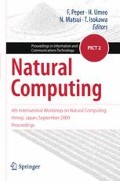Abstract
We have self-assembled organic molecular multi-level switch 2, 3-Dichloro-5,6-dicyano-1,4-benzoquinone (DDQ) as a functional cellular automaton circuit on an atomic flat gold 111 substrate where each molecule processes two bits of information. Since the logic-state transport rules could explain continuous transition of molecular states at every single molecular site in the molecular assembly, we can represent these transport rules as the cellular automata rules. Therefore, by analyzing the relative contrast of the molecules in the scanning tunneling current image it has been possible to reveal the spontaneous transport rules of molecular conductance states in terms of bits or digital signs. A dedicated program has been constructed to analyze the local changes (of single molecule) in the Scanning Tunneling Microscopic (STM) image of a molecular layer autonomously and the program is capable of extracting the elementary information transport rules from a series of STM images that depicts the evolution of a solution/phenomenon. Using this program, a rigorous statistical analysis of the surface transport of bits has been carried out. We have further programmed some of these rules to analyze the conventional CA computability on the organic molecular layer. Since we can tune the composition of molecular circuits, we can make some rules active and some rules passive. This feature has enabled us to carry out versatile and robust CA computation in the simulator. We have shown here with 10 examples how effectively conventional CA problems could be addressed exploring a few sets of rules of this 2 bit molecular cellular automata.
Access this chapter
Tax calculation will be finalised at checkout
Purchases are for personal use only
Preview
Unable to display preview. Download preview PDF.
References
Spezzano, G., Talia, D.: A High-Level Cellular Programming Model for Massively Parallel Processing. In: 1997 Workshop on High-Level Programming Models and Supportive Environments (HIPS 1997), p. 55 (1997)
Imai, K., Morita, K.: A computation-universal two-dimensional 8-state triangular reversible cellular automaton. Theoretical Computer Science 231(2), 181–191 (2000)
Wolfram, S.: Universality and complexity in cellular automata. Physica D 10, 1–35 (1984)
Bandyopadhyay, A., Fujita, D., Pati, R.: Architecture of a massive parallel processing nano brain operating 100 billion molecular neurons simultaneously. Int. J. Nanotech. and Mol. Comp. 1, 50–80 (2009)
Orlov, A.O., Amlani, I., Bernstein, G.H., Lent, C.S., Snider, G.L.: Realization of a functional cell for Quantum-dot Cellular Automata. Science 277, 928–930 (1997)
Imre, A., Csaba, G., Ji, L., Orlov, A., Bernstein, G.H., Porod, W.: Majority Logic gate for magnetic Quantum-dot Cellular Automata. Science 311, 205–208 (2006)
Gaylord, R.J., Nishidate, K.: Modeling Nature. Springer, Santa Clara (1996)
Durand-Lose, J.: Computing inside the billiard ball model, pp. 135–160. Springer, London (2001)
Korobov, A.: Discrete Versus Continual Description of Solid State Reaction Dynamics from the Angle of Meaningful Simulation. Discrete Dynamics in Nature and Society 4, 165–179 (2000)
Stone, C., Toth, R., Costello, B.D.L., Adamatzky, A., Bull, L.: Coevolving Cellular Automata with Memory for Chemical Computing: Boolean Logic Gates in the B-Z Reaction. In: Rudolph, G., Jansen, T., Lucas, S., Poloni, C., Beume, N. (eds.) PPSN 2008. LNCS, vol. 5199, pp. 579–588. Springer, Heidelberg (2008)
Cieplak, M.: Rupture and Coalescence in two-dimensional cellular automata fluids. Phys. Rev. E. 51, 4353–4361 (1995)
Morales, F.J., Crutchfield, J.P., Mitchell, M.: Evolving two-dimensional cellular automata to perform density classification: A report on work in progress. Parallel Computing 27(5), 571–585 (2001)
Oono, Y., Puri, S.: Computationally efficient modeling of ordering of quenched phases. Phys. Rev. Lett. 58, 836–839 (1987)
Deborah, M.G.: The development of organization of an ant colony. American Scientist 83, 50–57 (1995)
Pennisi, E.: The secret language of bacteria. The new scientist, 30–33 (1995)
Author information
Authors and Affiliations
Editor information
Editors and Affiliations
Rights and permissions
Copyright information
© 2010 Springer Tokyo
About this paper
Cite this paper
Bandyopadhyay, A., Bhartiya, R., Sahu, S., Fujita, D. (2010). Investigating Universal Computability of Conventional Cellular Automata Problems on an Organic Molecular Matrix. In: Peper, F., Umeo, H., Matsui, N., Isokawa, T. (eds) Natural Computing. Proceedings in Information and Communications Technology, vol 2. Springer, Tokyo. https://doi.org/10.1007/978-4-431-53868-4_1
Download citation
DOI: https://doi.org/10.1007/978-4-431-53868-4_1
Publisher Name: Springer, Tokyo
Print ISBN: 978-4-431-53867-7
Online ISBN: 978-4-431-53868-4
eBook Packages: Computer ScienceComputer Science (R0)

